The Gift of South Dakota
Subscriptions to South Dakota Magazine make great gifts!
Subscribe today — 1 year (6 issues) is just $29!
Holiday Foods Heritage
Editor’s Note: This story is revised from the Nov/Dec 1993 issue of South Dakota Magazine. To order a copy or to subscribe, call 800-456-5117.
On Christmas Eve in 1910, Emelia Nielson was a little disgruntled. Earlier that day she and her two-year-old daughter Esther had arrived in Hooker, South Dakota, just east of Viborg, by train, ending a long journey from Denmark. Emelia’s husband met them in the station. Chris had arrived months earlier to find a new home for his family.
“Mother said it was the worst Christmas she ever put in,” Esther recalled. Emelia, tired from the trip, declined an invitation to a Christmas party. Instead, Chris cooked bacon and eggs; dessert was lemon pie.
“Mother was wishing herself back in Denmark,” Esther said. “In America, they didn’t keep Christmas our way.”
Never again did Emelia have lemon pie at Christmas. She kept Christmas her way next year, and the years that followed, serving a robust Christmas dinner of roast goose, red cabbage, preserves and Danish apple cake.
“We always baked certain things: peppernuts, Danish puffs and Danish apple cake,” Esther said. “I was the oldest, so I always had to help. I was proud of that.”
South Dakotans still enjoy preparing dishes that are part of their heritage. Scandinavian specialties — rosettes, krumkake and lefse — are popular with Scandinavians and non-Scandinavians alike. As a nod to modern times, today’s cooks use a few shortcuts when they prepare dishes that celebrate their heritage at Christmas.
Baking most Scandinavian treats is time-intensive. The cook has to form each cookie or sweet individually. Sandbakkels, for instance, are made by pressing the dough into individual tart pans. After baking, the sandbakkels are gently tapped out of their pans one at a time.
When longtime Sioux Falls resident Rosaaen Olson visited her son in Norway, she decided to mother him with a batch of chocolate chip cookies. In the land of formed cookies, it wasn’t easy finding what she needed. “We couldn’t find a baking sheet anywhere,” Rosaaen recalled, “so we had to buy a pizza pan.”
Rosaaen’s been baking Julekake, Norwegian Christmas bread, for many years. It’s her middle son’s favorite; the youngest favors lefse. “If I’m going to do it, I’m going to do it big,” Rosaaen said. She doubles the Julekake recipe so it yields eight loaves, some earmarked for gifts. “The eggs and milk make a rich dough,” Rosaaen said. “That’s what makes it so good. Scandinavian bread has more body.”
No doubt, Scandinavians like their food plentiful at Christmas. “One child goes without a present,” Thomas Asfeldt mused, “to pay for all the candy.” His mother was raised in Denmark and moved to America when she was 21. At Christmastime in his Sioux Falls kitchen, Thomas makes liver pate, a spread always found on a traditional Danish Christmas buffet. His wife, Karen, a Norwegian from Webster, chooses treats from their Scandinavian heritage to try each year. Two of her favorites are Coffee Balls and Orange Marmalade. “I like to make those two because they can be done in an evening,” Karen said.
When Emelia Hansen arrived in Hooker one hundred years ago, she brought with her few material possessions, but she had a rich storehouse of traditions and memories. Her descendants are now stewards of those traditions.
Invited by the Smithsonian Institute, Esther traveled to Washington D. C. to demonstrate the Danish recipe aebleskiver. In a tent by the reflecting pool, Esther prepared aebleskiver, using knitting needles to turn over the muffin-like treats as they browned in a cast iron skillet.
Closer to home, a minister in Viborg asked Esther to help him recreate a Danish Christmas for a party at the church. Esther recited the Danish song, “Nu Er Det Jul Igen” (Now it is Christmas Again) while the minister wrote down the phonetic spelling. The minister tutored a choir of young Viborg residents.
“I had tears in my eyes. I was so proud of them, said Esther. “You’d swear they were a bunch of little Danes.”
Karen Asfeldt’s Marmalit (Marmalade)
3 to 5 oranges, washed clean
2 cups dried apricots
2 to 3 lemons, washed clean
1 cup sugar, or to taste
2 teaspoons vanilla
Do not peel the oranges and lemons. Cover and soak apricots in water for 3 to 4 hours. Cut fruit into wedges. Use food processor to mince the fruit. Add 1 cup sugar and 2 teaspoons vanilla. Stir and let sit for 20 minutes. Adjust sugar to taste. Store covered in refrigerator for 3 to 4 weeks.
Emelia Nielsen’s Danish Cookies
1 cup lard
3 eggs
1 cup butter
2 teaspoons baking ammonia (available at pharmacies or online) in a little water
Dash of cardamom
2 cups sugar
4 cups flour
Mix all ingredients into a stiff dough. Knead well, let stand and rest a while. Roll out thin, and cut with cookie wheel into shapes. Brush top with beaten egg and sprinkle with sugar. Bake at 375 degrees until light brown.
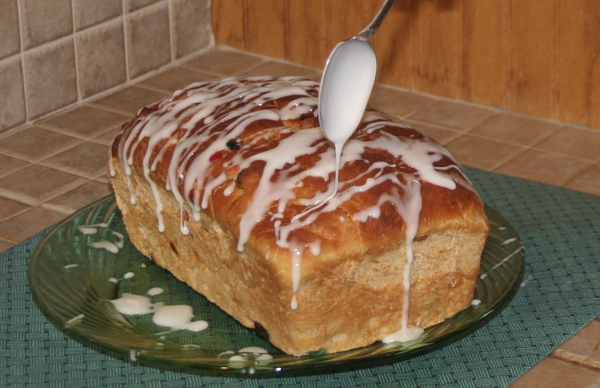 |
Rosaaen Olson’s Julekake (Christmas Bread)
1/2 cup butter
1/2 cup water
3 cups milk
2 packages dry yeast
3/4 cup sugar
2 teaspoons salt
1 teaspoon ground cardamom
10 cups flour
2 eggs
2 cups candied or dried fruit
Melt butter in 1/2 cup water and 3 cups milk. Put yeast, sugar, salt, cardamom and 5 cups of flour in a large bowl. Beat 2 eggs into milk mixture and add to all ingredients. Beat all 3 to 4 minutes. Gradually add about 5 cups flour. Mix in candied or dried fruit.
Let dough rise one hour or until doubled. Shape into four loves. Put into greased pan. Let rise again for one hour. Bake in preheated 350 degree oven for 35-40 minutes. Frost with powdered sugar frosting and top with slivered almonds.


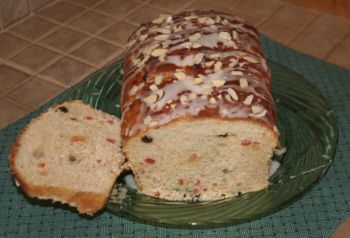
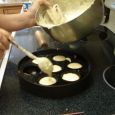

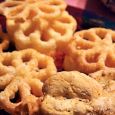
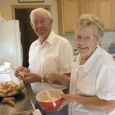

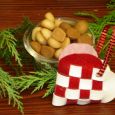


Comments
Nancy